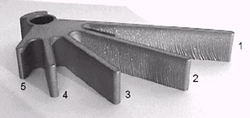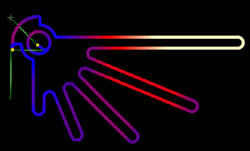Contributing Writer
- FMA
- The Fabricator
- FABTECH
- Canadian Metalworking
Categories
- Additive Manufacturing
- Aluminum Welding
- Arc Welding
- Assembly and Joining
- Automation and Robotics
- Bending and Forming
- Consumables
- Cutting and Weld Prep
- Electric Vehicles
- En Español
- Finishing
- Hydroforming
- Laser Cutting
- Laser Welding
- Machining
- Manufacturing Software
- Materials Handling
- Metals/Materials
- Oxyfuel Cutting
- Plasma Cutting
- Power Tools
- Punching and Other Holemaking
- Roll Forming
- Safety
- Sawing
- Shearing
- Shop Management
- Testing and Measuring
- Tube and Pipe Fabrication
- Tube and Pipe Production
- Waterjet Cutting
Industry Directory
Webcasts
Podcasts
FAB 40
Advertise
Subscribe
Account Login
Search
Not your father's abrasive jet
Technological advances, attention to common woes give fabricators options for precision cutting
- By Dr. John H. Olsen
- July 12, 2001
- Article
- Waterjet Cutting
Fifteen or 20 years ago abrasive jet was the technology of last resort for severing difficult materials that could be cut no other way.
These units were crude, noisy, and dirty. A nozzle was hung on an X-Y burning table and the resulting tolerances and surface finish were comparable to a burning operation, only slower. Operating these machines was almost an art form, a special skill by which experienced operators could make good parts while others could not. Few fabricators wanted one, and most abrasive jet cutting was done by specialty shops.
Today, things are different.
Modern machines can hold tolerances of +/- 0.005 inch or better. Noise and flying dirt can be minimized by underwater cutting. Abrasive jets still are useful for machining difficult materials such as INCONEL® alloys, titanium, and composites, but they also are widely used for easily cut materials such as mild steel and aluminum. Today abrasive jets are being placed in machine and fabrication shops alongside traditional machinery and operated by relatively unskilled labor. They are used for one-of-a-kind through medium-volume production. What changed?
The changes were the result of improvements in both nozzle and motion control technology.
Nozzle Technology
The first abrasive jet nozzles wore down so quickly that the jet would change its characteristics during production of a single large part. This made it impossible to hold tolerances. Early abrasive jets could be used only when subsequent machining could be performed or for very crude work.
Recent technological advances have improved this scenario, but users still should be cognizant of nozzle wear. As an abrasive jet nozzle wears, users first notice that the effective diameter of the tool begins increasing so that a larger and larger tool offset must be programmed into the motion to hold dimension. Then the cutting ability begins to drop, so much so that the surface finish degrades and a large taper appears in the cut. Finally the jet ceases cutting through the material.
The cause of these phenomena can be understood by examining the construction of an abrasive jet nozzle.
The workings of an abrasive jet nozzle are shown inFigure 1. Clean water traveling at forces up to 55,000 PSI is routed to a chamber directly above a sapphire orifice. The water accelerates through the orifice, forming a jet about 0.014 inch wide that is centered within a carbide tube 0.030 to 0.040 inch wide.
Abrasives enter the low-pressure region above the tube and are accelerated by the jet to form a high-speed slurry at the bottom of the tube. This slurry is the cutting tool. The cutting process is like grinding, except that abrasives are moved through the material by water rather than by a solid wheel.
The abrasives used in the cutting also wear away the carbide tube. If the tube changes its shape significantly during the manufacture of a part, it is impossible to make a precise part. New materials have increased tube life from as short as three or four hours to 50 or 100 hours. Once designers developed a way to maintain nozzle geometry, design improvements were made to improve both cutting speed and precision.
Motion Control
The second technology change was the advent of low-cost, powerful personal computers.
Modern PCs brought a major improvement in motion control. This improvement was needed because abrasive jets are not rigid tools. They bend backward in the cut by an amount determined by the motion speed and the workpiece properties. Figure 2shows the effect of speed on the lag of the jet and on the surface finish of the part. Speed decreases as the quality number increases from 1 through 5.
Obtaining an accurate yet low-cost part requires that the jet move fast where it can and slowly where the lag would cause part geometry errors. This speeding and slowing used to be performed by a skilled operator who had to adjust the feed rate override control constantly.
Modern machines have no feed rate override control because the expert system built into the PC control is much better at adjusting the speed than any operator could. Figure 3shows the speed variation required to make a good part efficiently. The colors represent the speed ranging from white at high speed through red to dark purple at low speed.
These speeds were calculated and set by the controller in response to the user's request for different quality levels on each of the five fingers. The input is made by setting colors on the part drawing in the CAD system as shown in Figure 4. Note that the speed varies as a function of part shape even though the cut quality is kept constant.
Figure 5shows the part setup screen for a modern abrasive jet machining center. A user can select the part to be made from any PC that is connected to a network that includes the machine. An image shows the part to be loaded. When the user selects the material as mild steel, a machinability factor of 87.6 automatically appears in the lower left corner. The user selects a plate thickness of 0.25 inch and enters a tool offset measured from a previous part. He also can select whether to rotate the part on the table or to scale it for temperature effects or other reasons. The software does the rest. No longer must operators look up the speed in a table and then watch the cut with his hand on the feed rate override control.
Finally, after variations caused by nozzle wear and poor speed control were eliminated, it became worthwhile to improve precision of the motion axes. Old machines were built on torch cutting gantries with either friction or rack-and-pinion drives. The ways often were simple angle iron with rollers. Today abrasive jet machines are built with machine tool-grade linear ways and ball screws. These high-precision components are protected from water and grit by bellows that completely seal all moving parts.
A Tool for Every Shop
With these changes, the market for abrasive jet machines also is changing. More and more shops are installing their own machines rather than relying on subcontractors.
Abrasive jet machining has changed from a specialty process for crudely severing a difficult material to a mainstream precision machining process that integrates well into a typical machine or fabrication shop.
INCONEL® is a registered trademark of Special Metals Corp.
About the Author

Dr. John H. Olsen
21409 72nd Ave. S.
Kent, WA 98032
253-872-2300
Related Companies
subscribe now

The Fabricator is North America's leading magazine for the metal forming and fabricating industry. The magazine delivers the news, technical articles, and case histories that enable fabricators to do their jobs more efficiently. The Fabricator has served the industry since 1970.
start your free subscription- Stay connected from anywhere

Easily access valuable industry resources now with full access to the digital edition of The Fabricator.

Easily access valuable industry resources now with full access to the digital edition of The Welder.

Easily access valuable industry resources now with full access to the digital edition of The Tube and Pipe Journal.
- Podcasting
- Podcast:
- The Fabricator Podcast
- Published:
- 04/30/2024
- Running Time:
- 53:00
Seth Feldman of Iowa-based Wertzbaugher Services joins The Fabricator Podcast to offer his take as a Gen Zer...
- Industry Events
Pipe and Tube Conference
- May 21 - 22, 2024
- Omaha, NE
World-Class Roll Forming Workshop
- June 5 - 6, 2024
- Louisville, KY
Advanced Laser Application Workshop
- June 25 - 27, 2024
- Novi, MI
Precision Press Brake Certificate Course
- July 31 - August 1, 2024
- Elgin,


































